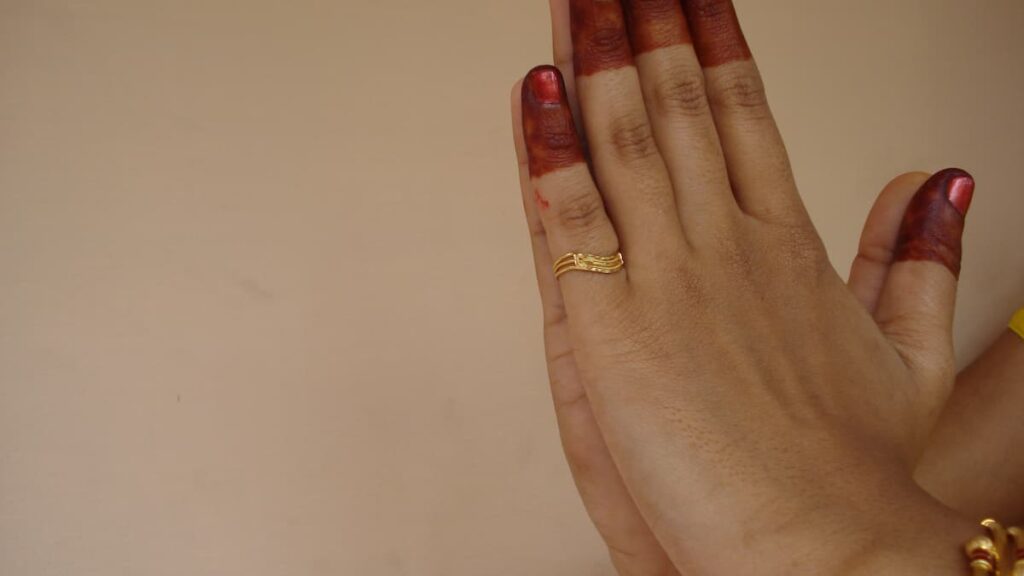What are the different types of Mudras?
This article mainly addresses this question. Mudra is a term that we often come across in yoga and meditation. Beyond this, we use it in many contexts. To understand it correctly, we should know the different types of them.
Before we see the classification, Let us understand what is the meaning of Mudras first.
What are Mudras?
In India, the Yogis, Rishis, Classic dancers, and Ayurvedic Practitioners have been using them from time immemorial.
They have been widely used in different use cases like Bharatha Natyam (classical dance of South India), Tantra, Vaidika Karmas, Yoga, and Meditation.
Mudras are gestures that influence the physical, psychological, psychic, and spiritual aspects of the performer.
Mudam anandam dadati iti mudra.
It means Mudra is the one that gives delight and pleasure. Yet, this is the literal meaning. We may call it a gesture or position, seal, or sign that gives delight. It is a symbolic gesture to give a specific message or attain certain desired results.
The Sanskrit term Mudra is derived from the root mud meaning delight.
According to its use case, Mudra has a specific meaning. For instance, in the classical dance of Bharatha Natyam, Mudra means a symbolic expression of a message. Likewise, in Srividya, they are used to please the deity. Similarly, in Ayurveda, they are used to attain elemental balance in the body to get rid of diseases, whereas, in Yoga and Meditation, they are used to attain a specific result. Hence, the meaning of Mudra differs according to its use case.
Types of Mudras
We may classify Mudras generally into two types.
- Hastha Mudras or Hand Gestures.
- Anga Mudras or Gestures using parts of the body (except Hand Gestures).
Hasta Mudras
Hasta Mudras are the symbolic gestures of hand using fingers mainly. Let us classify Hastha Mudras further.
- Bharatha Natya Mudras
- Tattwa Mudras
- Vaidika and Tantra Mudras
- Devadha Mudras
- Yoga and Dhyana Mudras
Bharatha Natya Mudras
Bharatha Natyam is a classical dance culture of India. It focuses on hand gestures, head movement, leg movement, eye movement, and other facial expressions. These gestures are Loukika Mudras that are not related to spiritual practices.
There are 55 Hand gestures approximately. Of which 32 gestures use only a single hand and the rest of them use both hands. The hand gestures that require the use of a single hand are known as Asamyuta Hastha Mudras. Similarly, hand gestures that use both hands are called Samyuta Hastha Mudras. Bharatha Natya Mudras are also known as Laukika Mudras.
Let us give an example image of Samyuta Mudra of Bharatha Natyam.

Tattwa Mudras
Pancha Tattwas or Five basic elements constitute the health of the body and mind. By performing hand gestures, we can balance these basic elements and cure diseases. Each of the five fingers represents each of the basic elements. We can control the energy flow and level by involving a specific finger that denotes the basic element.
The following table shows the five elements and the respective fingers associated with them.
| 1 | Fire | Thumb |
| 2 | Wind | Fore Finger |
| 3 | Ether | Middle Finger |
| 4 | Earth | Ring Finger |
| 5 | Water | Little Finger |
There are many Tattwa Mudras available of which we enumerate some important ones.
- Gyan Mudra
- Prithvi Mudra
- Vayu Mudra
- Varuna Mudra
- Shunya Mudra
- Surya Mudra
- Prana Mudra
- Apana Mudra
- Linga Mudra
Vaidika and Tantra Mudras
Vaidika Mudras are again classified as below.
- Guru Vandhana Mudras ( Gestures/Signs for worshipping Guru)
- Arkya Sthabhana Mudras
- Avahanadhi Mudras (Gestures for invoking the deity)
- Nyasa Mudras
- Nivedana Mudras
While worshiping a deity, Pooja/Vaidika Mudras are performed.
- Avahani
- Samsthabhani
- Samnidhabhani
- Samniridhani
- Sammukheekarani
- Vandhani
- Tattwa Mudra
- Gyana Mudra
- Samhara Mudra
Nyasa Mudras
- Mukha
- Karasamputa
- Hrudhaya
- Sira
- Sikha
- Kavacha
- Netra
- Astra
Devadha Mudras
These are the hand gestures shown by Hindu, Buddhist, and Jaina Deities. We can easily find these gestures in statues of temples and spiritual places. There are two important gestures.
- Abhaya Mudra
- Varadha Mudra
Abhaya Mudra
Abhaya means no fear or fearlessness. The deity symbolically gestures the protection of the worshipper by all means.
Varadha Mudra
Varadha means giving boons. The deity symbolically gestures providing the boons to fulfill all the wishes of the worshipper.
Anga Mudras
Anga Mudras are gestures that are not Hand Gestures. The Sanskrit term Anga means parts of the body. This classification is for the convenience of understanding. They are mostly yoga and meditation gestures. According to Gheranda Samhita, there are twenty-five Yoga Mudras.
- Maha Mudra
- Nabho Mudra
- Uddiyana
- Jalandhara
- Mula Bandha
- Maha Bandha
- Maha Vedha Mudra or Maha Bheda Mudra
- Khechari Mudra
- Viparitakarani Mudra or Viparitakari
- Yoni Mudra
- Vajroni Mudra
- Sakthi Chalani Mudra
- Tadagi Mudra
- Mandavi Mudra
- Shambhavi Mudra
- Pancha Dharana Mudras – Prithvi Dharana Mudra
- Pancha Dharana Mudras – Varuna Dharana Mudra
- Pancha Dharana Mudras – Vayu Dharana Mudra
- Pancha Dharana Mudras – Agni Dharana Mudra
- Pancha Dharana Mudras- Akasa Dharana Mudra
- Ashwini Mudra
- Pasini Mudra
- Kaki Mudra
- Matangi Mudra
- Bhujangini Mudra
Besides, Chin Mudra and Gyan Mudra are the most important Mudras for Pranayama and meditation.
Bottom Line
Many hundreds of Mudras are in practice. This is only the list and type of important ones.


